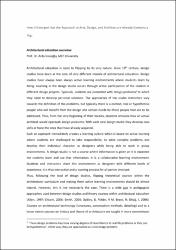Please use this identifier to cite or link to this item:
https://hdl.handle.net/20.500.11779/402| Title: | How It Emerged That the Approach To Arts, Design, and Architecture Already Contains a Flip | Authors: | İnceoğlu, Arda | Keywords: | Architecture Flipped learning Architectural education |
Publisher: | Emerald Group Publishing | Source: | Inceoglu A. (2016) ‘How it emerged that the approach to Arts, Design and Architecture already contains a Flip’ in Şahin, M; Fell Kurban, C. F. (eds.) The Flipped Approach to Higher Education: Designing Universities for Today's Knowledge Economies and Societies. Emerald Group Publishing, pp 165-173. | Abstract: | Architectural education is open to Flipping by its very nature. Since 19th century, design studios have been at the core of very different models of architectural education. Design studios have always been always active learning environments where students learn by doing. Typically, students are presented with design problems to which they need to develop personal solutions. Thus, from the very beginning of their studies, students simulate how an actual architect would approach design problems. With each new design studio, they develop new skills or hone the ones they have already acquired. Such an approach immediately creates a learning culture which is based on active learning where students are challenged to take responsibility, to solve complex problems and develop their individual character as designers while being able to work in group environments. A design studio is not a course where information is given an it is expected the students learn and use that information. It is a collaborative learning environment. Thus, following the lead of design studios, flipping theoretical courses within the architectural curriculum and making them active learning environments should be almost natural. However, this is not necessarily the case. There is a wide gap in pedagogical approaches used between design studios and theory courses within architectural education (Allen, 1997; Chiuini, 2006; Smith, 2004; Oakley, B, Felder, R M, Brent, R; Elhajj, I, 2004). Courses on architectural technology (structures, construction methods, detailing) and to a lesser extent courses on history and theory of architecture are taught in more conventional ways with little emphasis on the application of the information discussed (Vassigh, 2005, 2009). Within this context, it is important to find ways to develop non-studio courses as active learning environments. | URI: | https://hdl.handle.net/20.500.11779/402 |
| Appears in Collections: | Mimarlık Bölümü Koleksiyonu WoS İndeksli Yayınlar Koleksiyonu / WoS Indexed Publications Collection |
Files in This Item:
| File | Description | Size | Format | |
|---|---|---|---|---|
| How it Emerged that the Approach to Arts, Design, and Architecture Already Contains a Flip.pdf | Yazar Sürümü_Kitap Bölümü | 20.31 MB | Adobe PDF |  View/Open |
CORE Recommender
Page view(s)
36
checked on Nov 18, 2024
Download(s)
6
checked on Nov 18, 2024
Google ScholarTM
Check
Items in GCRIS Repository are protected by copyright, with all rights reserved, unless otherwise indicated.